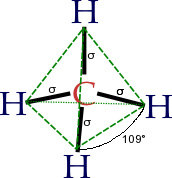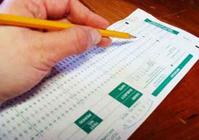Organic Chemistry Sample Test Questions - Part I
SPO VIRTUAL CLASSROOMS
Organic Chemistry
Practice Test Questions I
Virtual Cell Biology Classroom of Science Prof Online
 | ||||||
1. Glucose is a...
a. polysaccharide
b. dipeptide
c. monosaccharide
d. fatty acid
e. polypeptide
2. Peptide bonds link amino acids together to form polypeptides.
a. True b. False
3. The pairing of nitrogenous bases make up the "rungs" of the DNA "ladder". Which base in a DNA molecule can form hydrogen bonds with thymine?
a. thymine
b. uracil
c. guanine
d. adenine
e. cytosine
4. The "energy currency" used within cells is called:
a. Euro
b. adenosine triphosphate (ATP)
c. adenosine monophosphate (AMP)
d. ribose
e. deoxyribonucleic acid (DNA)
5. Which two answers best describe what would be found in a triglyceride?
#1. glycerol
#2. one fatty acid
#3. two fatty acids
#4. three fatty acids
#5. nucleoside
#6. amino acid
a. 4, 5 b. 1, 2 c. 1, 4 d. 4, 6 e. 1, 5
6. How many atoms of hydrogen (H) are able to bond with one carbon (C) atom?
a. one b. two c. three d. four e. five
The following questions, from the Virtual Cell Biology Classroom, are designed to help students better understand Organic Chemistry. All questions are based on material that can be found on the Organic Chemistry Lecture Main Page.
 | ||||
Free review questions to help students better understand
Page last updated:
2/2016
You have FREE access to a large collection of materials used in a college-level introductory biology course. The Virtual Biology Classroom provides a wide range of free educational resources including PowerPoint Lectures, Study Guides, Review Questions & Practice Test Questions.
7. Which of the following are biologically important polymers (large molecules composed of subunits called monomers)?
#1. polysaccharide
#2. monosaccharide
#3. amino acids
#4. proteins
#5. nucleotides
#6. DNA
a. 3, 6 b. 1, 4, 6 c. 2, 3, 4 d. 1, 2, 3, 4, 5, 6 e. 4, 6
8. DNA is a polymer made of nucleotide units which each consist of:
a. an amino acid, a peptide and a sugar
b. one of more phosphate groups, an amino acid & a phospholipid
c. a fatty acid, a sugar and a phosphate group
d. a pentose sugar, one or more phosphate groups and a base
9. The type of lipid molecules that are polar and spontaneously arrange in a lipid bilayer are:
a. proteins b. fats c. waxes d. phospholipids
10.Which molecule carries the least energy?
a. ADP b. ATP c. AMP
 | ||||||
SPO offers free PowerPoint lectures, sample test
questions, review questions and assignments on many different science topics.
Below are links to those that relate to chemistry:




